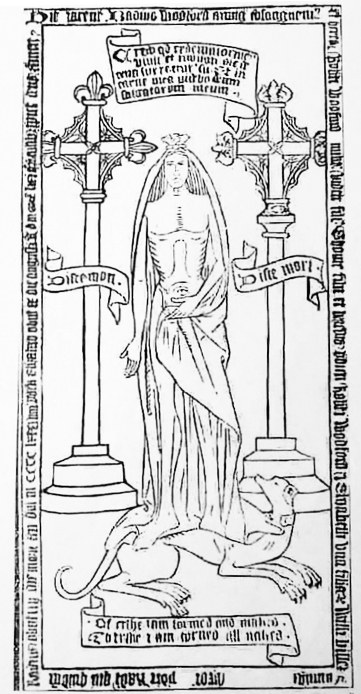The Tomb of Ralph Woodford
The tomb of Ralph Woodford in St Mary's Church, Ashby Folville, has survived in a
remarkably good condition. It is one of the finest examples of an incised slab in
Leicestershire and is the only shrouded figure on a Leicestershire or
Rutland monumental slab.

Over the head of the effigy on another folded scroll is the Latin text of Job, Ch 19 v.25/26:
CREDO Q(UO)D REDEMPTOR ME(US)
VIVIT ET NOVI(SSI) MO DIE DE
TERRA SURRECTUR(US) SU(M). ET IN
CARNE MEA VIDEBO DEUM
SALVATORUM MEUM
Beneath the figure's feet on a fourth scroll are the
English verses:
OF ERTHE I AM FORMED & NAKED
TO ERTHE I AM TURNED ALL NAKED
John Nichols (History and Antiquities of the County of Leicester) omits the second sentence of the Latin text and the entire English couplet in his description of the tomb.
The marginal inscription begins in the top right-hand corner and reads outwards:
HIC IACENT RAD(ULPH)IUS WODFORD ARMIG(ER) CO(N) SANGUENI(US) / ET HERES ROB(ER)TI WODFORD MILIT(IS) VIDEL(I CE)T FILI(US) THOME FILII ET HEREDIS P(RE)DICTI ROB(ER)TO WODFORD & ELIZABETH UNA FILIA(RUM) WILL(IELM)I VILLIERS / ARMIG(ER)I UXOR P(RE)DIC(TI

A further theory is that the design was first drawn out in some form of black pigment. It was then approved by Ralph and the engraver began his work but forgot to
complete the head; but as all the lines were filled level with pitch
after engraving, the omission escaped detection at the time. By 1800 when
Nichols was compiling his work, the original setting out of the head had
worn off and at some date between then and the present day, another
engraver completed the figure. While instances do occur of figures entirely shrouded, there are no examples known where part of the body is left uncovered but the entire head is shrouded. It is unthinkable to argue that the monument could have been delivered with such a glaring error as the omission of the head of the subject.
Excavations below the Woodford slab in 1871
revealed the remains of two skeletons.
Jon Denton (see source reference below) writes: 'Ralph Woodford placed considerable importance on preparing for death and commemoration within his own lifetime. The selection of imagery for his commemorative media must, therefore, be attributed to his own tastes and concerns. The liturgical vocabulary and location of the tomb demonstrate a considerable understanding of the content and mechanisms of the religion that he practised.'
Sources:
BL, Cotton Claudius A XIII f.3 (The Woodford Cartulary)
F.A.Greenhill, The Incised Slabs of Leicestershire and Rutland, LAHS, 1958.
Jon Denton, Image, Identity and Gentility: The Woodford Experience, in The Fifteenth Century: Of Mice and Men: Image, Belief and Regulation in Late Medieval England, Editor, Linda Clark, The Boydell Press, 2005.
